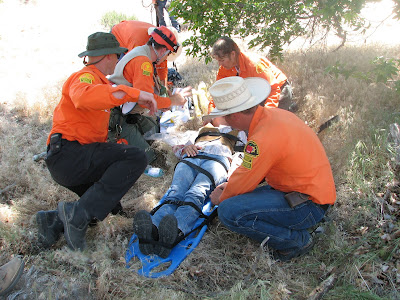Mounted SAR Training 2012
 Thursday, May 24, 2012 at 7:37
Thursday, May 24, 2012 at 7:37  Dean Mott
Dean Mott On behalf of Apple Valley Posse, I want to thank every individual who came out to the 2012 All County MSAR event regardless of role. This exercise was realistic, challenging, and I feel an astounding success! We did suffer one injury to a mount and our best wishes go out to the mount and owner.
It was a long day with a lot of lessons learned. We wanted to attack our training from a mission focused approach as compared to a trail-ride approach. At the end of the day’s training, I was asked by a highly respected MSAR technician if we had achieved what we set out to do when the training was complete. At the time, my answer was a bit of a ramble. I would like to better answer that question here:
- As stated on that day, training to this degree requires planning and the efforts and cooperation of the entire unit as a team. We achieved that to perfection and it reflected in a great training day.
- We wanted to academically discuss issues related to MSAR, present new information as to how we can possibly operate faster, safer, more efficiently in the field and still have a sound horse under us at the end of the day. We discussed tips for improved mounted navigation that doesn’t rely on electronic gadgets. We also discussed Executional Decision Making (EDM); a methodical and rapid process of mission planning and risk mitigation for the team leader. Lastly, we demonstrated sound methods of stock management and wrangler duties in addition to standard SAR tasks within the team. I think we achieved most of these given that the topics can be limitless and we budgeted ourselves with two hours of discussion time.
- We wanted to present a highly realistic scenario that was plausible – a repeat of an actual event from the past – in terrain suitable to mounted units. Nothing was fictitious or random. Teams were required to track as well as use loose grid formations with established base lines. All evidence led directly to the subject who was visibly wounded, bleeding, and suffered a compound fracture. We utilized actual medical gear to demonstrate the challenges encountered with back boards, oxygen, IVs, splints, and other medical logistics when dealing with trauma cases. We achieved all of this.
- We wanted to demonstrate and validate the mounted packing program in a realistic support role it could fill; in this case the AEMT program. Our pack teams transported the medical gear listed above in the field as part of the search teams to hasten its arrival to the subject upon discovery. This concept worked in spades! We proved and received feedback that mounted packers are not only freight haulers, but are also valuable wranglers, leaders, trackers, and can perform every other BSAR task required in the field.
- We wanted to demonstrate that Helitack skills are viable in MSAR; that the presence of horses in and around an LZ can still do their jobs. True, they can and do add to the element of risk, but with proper training, leadership and management, mounted teams demonstrated that they can provide First-Aid to a subject, execute stock management, establish and secure suitable LZs, and communicate with inbound aircraft. We clearly showed that training in these skills is not wasted effort; that these talents do have merit in MSAR, and that qualified MSAR units can and should be called upon to train for and execute these tasks when required. Though we had primary and secondary aviation resources dedicated to the task, unfortunately both arrived overhead only to be called away to real world events. Sadly, the landing and subject-loading phase of the training did not occur. Next time!
- Lastly, we learned that MSAR is woefully lacking in medical technicians organic to our discipline and identified a potential recruiting objective. Though we demonstrated that we have the capability of transporting equipment and providing direct support to the on-scene medic, integrating mounted and ground resources still leaves questions and should be explored with additional joint training in the future.
 |
| From MSAR Training 2012 |
 |
| From MSAR Training 2012 |
In taking a lesson from our distant history, nothing we do in the mounted community is new. Armies from around the globe have used mounted units to be the eyes and ears of the commander; to haul equipment, to provide speed, mobility, maneuver, and to go into and out of terrain inaccessible to other resources. Only technology has changed. The Incident Commander still needs the same information and skill sets that we can provide, and newer technology provides us greater flexibility with which to provide them.
We had a great deal of support for this exercise from a multitude of agencies. I sincerely give my personal thanks to all county members and their stock who participated in this training; to Volunteer Forces for their assistance and resources, to the IESARC for their participation, guidance and mentorship, to our coordinators and the Victor Valley Station for the same, to Sheriff’s Aviation and our brethren in Mercy Air for their dedication to support this effort and ensure its success. If you have any questions, comments, or concerns regarding this training, please contact Dean Mott, AVSP 1LT and Training Officer at dmott@sbsar.org.

Reader Comments